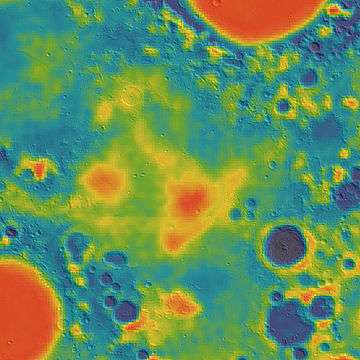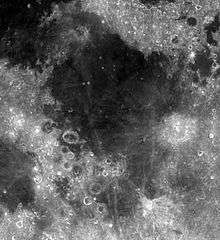Mare Fecunditatis
|
Mare Fecunditatis | |
| Coordinates | 7°48′S 51°18′E / 7.8°S 51.3°ECoordinates: 7°48′S 51°18′E / 7.8°S 51.3°E |
|---|---|
| Diameter | 840 km (520 mi)[1] |
| Eponym | Sea of Fertility |
Mare Fecunditatis (the "Sea of Fecundity" or "Sea of Fertility") is a lunar mare which is 840 km in diameter. The Fecunditatis basin formed in the Pre-Nectarian epoch, while the basin material surrounding the mare is of the Nectarian epoch. The mare material is of the Upper Imbrian epoch and is relatively thin compared to Mare Crisium or Mare Tranquillitatis. This basin is overlapped with the Nectaris, Tranquillitatis, and Crisium basins. Fecunditatis basin meets Nectaris basin along Fecunditatis' western edge, with the area along this zone faulted by arcuated grabens. On the eastern edge of Fecunditatis is the crater Langrenus. Near the center lie the interesting craters Messier and Messier A. It was here that the first automated sample return took place via the Luna 16 probe, in September 1970. Sinus Successus lies along the eastern edge of the mare.
Unlike many other maria, there is no mass concentration (mascon), or gravitational high, in the center of Mare Fecunditatis. Mascons were identified in the center of other maria (such as Serenitatis or Imbrium) from Doppler tracking of the five Lunar Orbiter spacecraft in 1968.[2] The gravity field was mapped at higher resolution with later orbiters such as Lunar Prospector and GRAIL, which unveiled an irregular pattern.
 Topographic map
Topographic map Gravity map based on GRAIL
Gravity map based on GRAIL
References
- ↑ "Moon Mare/Maria". Gazetteer of Planetary Nomenclature. USGS Astrogeology. Retrieved 2010-08-20.
- ↑ P. M. Muller, W. L. Sjogren (1968). "Mascons: Lunar Mass Concentrations". Science. 161 (3842): 680–684. doi:10.1126/science.161.3842.680.
